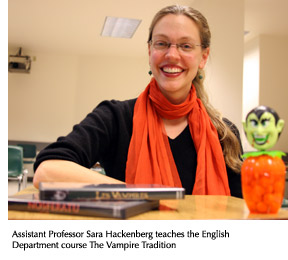| |
|||||
|
Students study 'The Vampire Tradition' | ||||
|
November 22, 2006 |
|||||
 A
new class has students sinking their teeth into the sexy, gory and allegorical
world of vampires. A
new class has students sinking their teeth into the sexy, gory and allegorical
world of vampires.
The Vampire Tradition is offered in the English Language and Literature Department and taught by Assistant Professor Sara Hackenberg, whose doctoral dissertation focused on 19th century mystery, detective fiction and supernatural tales with gothic and mystery elements. According to her syllabus, the class explores how "the vampire has become a rich and complex icon in our literary and media culture, harnessing and revealing our desires, obsessions and anxieties about otherness, morality and identity." The three-unit class, which can count toward general education requirements, includes readings from such well-known classics as Bram Stoker's "Dracula" and Edgar Allen Poe's "Ligeia," as well as other historic literature including James Malcolm Rhymer's "Varney the Vampyre: Or, the Feast of Blood" and Mary Elizabeth Braddon's "Good Lady Ducayne." "You don't realize how versatile vampires are," sophomore Erik Goad said in a story about the class in the Oct. 28 edition of the San Francisco Chronicle. "They're great characters. All about good and evil, darkness and light." Hackenberg, who joined SF State in 2004, said vampires have been a mainstay in popular culture for several centuries because they tug at the heart of human existence and the desires for food and sex. "Every culture has vampire stories," she said. "It helps us work out these theories of existence." Three of the authors explored in the class have ties to SF State. Alum Anne Rice published her short story "Freniere" in 1976, the same year as her breakthrough best-seller "Interview with a Vampire." Jewelle Gomez, a former director of SF State's Poetry Center and American Poetry Archives, wrote the award-winning "Gilda Stories," about an African American lesbian vampire who escaped slavery in the 1850s. Alum Chelsea Quinn-Yarbro, the first woman named a "Living Legend" by the International Horror Guild, created the Saint-Germain vampire series. As discussed in class, vampires can be foiled in more ways than the old garlic trick. Stabbings, decapitations, removal of the heart or liver, and slashing off of hands can also be effective. Class discussions may sometimes cause the squeamish to squirm in their seats, but are enjoyed by horror fans and those who identify with gothic culture. "She had a male monster figure yank her hair back and penetrate her neck with his teeth," Hackenberg said one day when describing a scene in "Varney the Vampyre." It's not for shock value, but rather to explore symbolism relating to gender, sexuality, morality and sociology. "Students' instincts are sharp for this genre," Hackenberg said. The class also studies vampires in film and television. The popular television drama "Buffy the Vampire Slayer" has become a hot topic recently in academic circles and presents a great opportunity to study material to which students relate, Hackenberg said. "['Buffy' uses] the supernatural form to talk about peer pressure and drug addiction," she said. "Students don't yet have the terminology to call it allegory, but they know that vampires represent something important and more than what they are." On Halloween, as an extension of the readings, five students received extra credit for dressing as characters explored in class. Tim Sherrill, a senior majoring in English literature, was well-received for his costume of the title character in "Carmilla," written by Joseph Sheridan Le Fanu in 1872. "She's fascinating," Sherrill said of Carmilla. "She is one of the early, fully developed and femme-fatale vampires." -- Matt Itelson
|
|||||
 |
1600 Holloway Avenue, San Francisco, CA 94132 (415) 338-1111 |